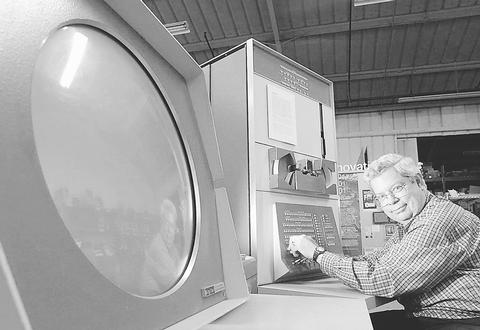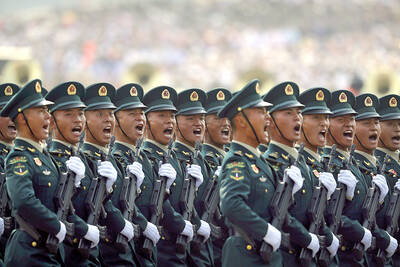Not long ago Steve Russell sat in a darkened movie theater watching the army of credits roll by after a computer-animated Hollywood blockbuster.
There was a time, he recalls thinking, when a cutting-edge computer-generated fantasy could be conceived, written, tested and packaged for distribution in a few months, just through the part-time efforts of a small group of friends.
To be precise, that time was 40 years ago this month, with the result played out on a computer screen at the Massachusetts Institute of Technology. Two tiny spaceships were locked in mortal combat as they swung around a simulated sun. The duel was called Spacewar.

PHOTO: NY TIMES
Designed by a small group of pioneering computer programmers led by Russell, it was the world's first video game. It was an early hint that a powerful new entertainment medium was on the horizon, one that would ultimately bond Silicon Valley to Hollywood. Perhaps most significantly, Spacewar demonstrated that sheer fun would become a driving force underlying progress in computing technology.
Over the years it played a crucial role in inspiring the creators of companies like Apple and Atari, said Henry Lowood, the curator of Stanford University's collections on the history of science and technology. "It set off a chain of events that created companies and led to a whole idea of what Silicon Valley would be," he said.
It certainly established at least one stereotype of the high-tech age: a few frenzied geeks in their twenties obsessively laboring after hours in a computer lab on a creation that combined play and programming. But the premise of Spacewar seemed to reflect the specific preoccupations of that moment in the early 1960s. It was completed the same month that John Glenn made the nation's first manned orbital flight. And the Cold War was at its most perilous stage: The Berlin Wall had just gone up, and the Cuban missile crisis would soon follow.
Now those 20-something geeks are near or past retirement age. Unlike more recent generations of computing and Internet pioneers, Spacewar's six programmers did not find fortune from their invention. Their achievement has made them legends only among a fraternity of the world's original computer hackers.
"The only money I made from Spacewar was as a consultant for lawsuits in the video game industry in the 1970s," said one of the game's creators, Alan Kotok. "I have all this fame, but it's in a very narrow circle."
Kotok and the other members of the original team all remained part of that circle, pursuing careers in computers. Several became hardware designers, several went on to write software, one became a professor and one joined the secretive National Security Agency.
Their early creation is now a museum piece -- literally -- reflecting the software principles and programming culture of its era.
Designed to take advantage of Digital Equipment Corp's brand-new PDP-1 minicomputer and the advent of a cathode-ray display screen, Spacewar was written before software was patented, and the original programmers' instructions were shared and freely modified by a small group of software designers.
Introduced some months later at Decus, which was then a Digital Equipment Corp users' group, Spacewar immediately attracted a cult following. It became so addictive that at the MIT laboratory where it was designed, play was soon banned except during lunchtime and after working hours.
Spacewar was the original "twitch" game, requiring lightning reflexes. Each player used keyboard controls or a joystick to maneuver a tiny ship capable of firing a stream of torpedoes as it slid across the screen. Before long a "hyperspace" option was added so that a player could make his ship vanish and reappear at a random place on the screen, avoiding certain death.
Stewart Brand, founder of The Whole Earth Catalog, saw the game played by young hackers at Stanford's computer center in the early 1960s. "They were absolutely out of their bodies, like they were in another world," he recalled. "Once you experienced this, nothing else would do. This was beyond psychedelics. It impressed the heck out of me."
In fact, though they came to be known for their hours in front of a computer screen, the game's creators initially met through MIT's hiking club. The group was led by Russell, known as Slug, and Martin Graetz, known as Shag, both devoted science fiction fans who wondered why better science fiction movies weren't being made.
Another contributor, Peter Samson, then a 21-year old undergraduate studying engineering at MIT, added a crucial component called "expensive planetarium," an accurate scrolling star field that portrayed the night sky over Cambridge.
Spacewar began in January 1962 as a simple object-in-motion program, Graetz said, and by February had become a rudimentary game, including two ships, a supply of fuel and a store of torpedoes.
Both Russell and Kotok said it was never their intent to create a new digital entertainment medium. After the new Digital Equipment computer with its display was installed in late 1961, the group simply began thinking about what might be the best way to demonstrate the power of the new machine and hit on the idea of a graphical simulation of a battle between two spaceships.
Mind-blowing concept
Spacewar was an obvious choice, but no one in the group sensed what impact the program would have over a decade-and-a-half of popularity.
"One of the things that drew me to the project was that here you could do interaction and painless education and demonstration, and it was engaging," said Russell, a 24-year-old programmer at the time.
After agreeing to be the lead programmer on the project, Russell said he procrastinated until Kodak drove to Digital Equipment and returned with a paper tape containing necessary math subroutines. He then set to work by entering code on a Flexowriter, a typewriter device that translated commands into holes punched in paper tape.
Perhaps the most impressive feat was that Spacewar worked at all. The processor for the PDP-1 minicomputer ran at about 100,000 instructions per second, snail-like in comparison with the speed of today's fastest microprocessors, which exceed two billion instructions per second.
Moreover, the computer, which was built from discrete transistors, had to make the most of about nine kilobytes of random access memory, unfathomably little compared with the RAM of today's desktop machines, which can boast as much as one gigabyte -- a million kilobytes.
"Each new game tends to push the state of the art," said Richard F. Rashid, who heads research at Microsoft. "They stretch the machine as far as you can stretch it."
Moreover, the Spacewar program became an integral part of a spreading hackers' culture as it was carried on punched paper tape to the dozen or so research centers and universities that had the early PDP minicomputer.
"What I was most pleased with was that a number of people saw Spacewar and went off and said, `I can do that' and then implemented their version on another system without looking at the source code," Russell said.
One of those inspired by the game was Nolan Bushnell, who went on to found the Atari Corp. He was first seized by the idea of commercializing video-game technology when he came across a version of Spacewar while a graduate student in engineering at the University of Utah.
In 1971 he introduced an arcade version of Spacewar called Computer Space, which was a commercial flop. Bushnell kept at it, though, and soon introduced the more successful Pong.
The game also made an impression on two other entrepreneurs-to-be, Steve Jobs and Steve Wozniak, the founders of Apple Computer, who as teenagers would ride their bicycles to Stanford's artificial intelligence lab, where the game was frequently played.
But credit for the first commercial video game actually goes to Bill Pitts, a Stanford graduate who, with a high school friend, Hugh Tuck, installed Galaxy Game, a coin-operated version of Spacewar, in Stanford's student union several months before Bushnell introduced Computer Space.
It became a huge hit and was played by students for more than six years, allowing Pitts to pay back the US$60,000 he had invested in the project. Today his version of Spacewar can be found at the Computer Museum History Center in Mountain View, California, where it has been restored for play on a vintage Digital Equipment PDP-11.
For his part, Russell, now 64, is only an occasional gamer. He visits arcades to keep up with video game technology and spends a couple of hours a month playing at his own PC. But his tastes, like the times, have changed. Now it is solitaire, not spaceships, that keeps him coming back.

MORE VISITORS: The Tourism Administration said that it is seeing positive prospects in its efforts to expand the tourism market in North America and Europe Taiwan has been ranked as the cheapest place in the world to travel to this year, based on a list recommended by NerdWallet. The San Francisco-based personal finance company said that Taiwan topped the list of 16 nations it chose for budget travelers because US tourists do not need visas and travelers can easily have a good meal for less than US$10. A bus ride in Taipei costs just under US$0.50, while subway rides start at US$0.60, the firm said, adding that public transportation in Taiwan is easy to navigate. The firm also called Taiwan a “food lover’s paradise,” citing inexpensive breakfast stalls

US PUBLICATION: The results indicated a change in attitude after a 2023 survey showed 55 percent supported full-scale war to achieve unification, the report said More than half of Chinese were against the use of force to unify with Taiwan under any circumstances, a survey conducted by the Atlanta, Georgia-based Carter Center and Emory University found. The survey results, which were released on Wednesday in a report titled “Sovereignty, Security, & US-China Relations: Chinese Public Opinion,” showed that 55.1 percent of respondents agreed or somewhat agreed that “the Taiwan problem should not be resolved using force under any circumstances,” while 24.5 percent “strongly” or “somewhat” disagreed with the statement. The results indicated a change in attitude after a survey published in “Assessing Public Support for (Non)Peaceful Unification

PLUGGING HOLES: The amendments would bring the legislation in line with systems found in other countries such as Japan and the US, Legislator Chen Kuan-ting said Democratic Progressive Party (DPP) Legislator Chen Kuan-ting (陳冠廷) has proposed amending national security legislation amid a spate of espionage cases. Potential gaps in security vetting procedures for personnel with access to sensitive information prompted him to propose the amendments, which would introduce changes to Article 14 of the Classified National Security Information Protection Act (國家機密保護法), Chen said yesterday. The proposal, which aims to enhance interagency vetting procedures and reduce the risk of classified information leaks, would establish a comprehensive security clearance system in Taiwan, he said. The amendment would require character and loyalty checks for civil servants and intelligence personnel prior to

The China Coast Guard has seized control of a disputed reef near a major Philippine military outpost in the South China Sea, Beijing’s state media said, adding to longstanding territorial tensions with Manila. Beijing claims sovereignty over almost all of the South China Sea and has waved away competing assertions from other countries as well as an international ruling that its position has no legal basis. China and the Philippines have engaged in months of confrontations in the contested waters, and Manila is taking part in sweeping joint military drills with the US which Beijing has slammed as destabilizing. The Chinese coast guard